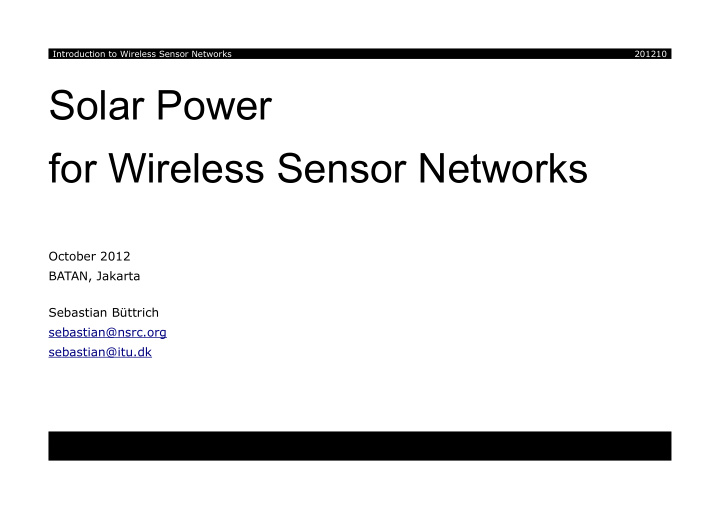



Introduction to Wireless Sensor Networks 201210 Solar Power for Wireless Sensor Networks October 2012 BATAN, Jakarta Sebastian Büttrich sebastian@nsrc.org sebastian@itu.dk 1/42
Introduction to Wireless Sensor Networks 201210 MANA project Greenland http://itu.dk/mana 2/42
Introduction to Wireless Sensor Networks 201210 Solar power May refer to thermal, electric and other forms of powering Here, we talk about photovoltaic power the production of electric energy by means of photovoltaic panels. 3/42
Introduction to Wireless Sensor Networks 201210 Principle Photovoltaic panels Generate electric power (DC) through the separation of electric charges in a pn junction in semiconductor materials, mostly Silicon based, but also other materials. Note: there are other types of solar panels too – see slide on research! 4/42
Introduction to Wireless Sensor Networks 201210 Types of solar power deployments On grid May deliver energy back to the grid AC, inverters needed for AC/DC conversion Off grid Autonomous systems, may or may not need AC. In the case of WSN, we typically look at these autonomous systems 5/42
Introduction to Wireless Sensor Networks 201210 Elements of pv setup Photovoltaic panel Charge controller Battery Load / Consumer Optionally: Inverter (AC) 6/42
Introduction to Wireless Sensor Networks 201210 Types of solar cells Monochrystalline 7/42
Introduction to Wireless Sensor Networks 201210 Types of solar cells Polychrystalline 8/42
Introduction to Wireless Sensor Networks 201210 Types of solar cells Thin Film, flexible e.g. CIGS Copper indium gallium selenide (CuInxGa(1-x)Se2) 9/42
Introduction to Wireless Sensor Networks 201210 Batteries • Need to be suitable type for solar charging cycles: deep cycle batteries, optimized for many rounds of charge and discharge • Often of type GEL battery (closed Lead Acid) • Should never be depleted completely • Battery capacity is measured in Ah (Amperehours) or Wh (Watthours) 10/42
Introduction to Wireless Sensor Networks 201210 11/42
Introduction to Wireless Sensor Networks 201210 • WSN sensor boards might have special types of batteries – we might look at systems with huge battery banks of 1000s Ah or just a tiny Li battery that is being trickle charged. 12/42
Introduction to Wireless Sensor Networks 201210 Example: 2 x 200Ah batteries 13/42
Introduction to Wireless Sensor Networks 201210 Charge Controller Intelligent control of charging process Capacity control Power conditioning 14/42
Introduction to Wireless Sensor Networks 201210 15/42
Introduction to Wireless Sensor Networks 201210 Photovoltaic systems in all sizes 16/42
Introduction to Wireless Sensor Networks 201210 17/42
Introduction to Wireless Sensor Networks 201210 18/42
Introduction to Wireless Sensor Networks 201210 pv integrated in sensor node: Memsic Eko 19/42
Introduction to Wireless Sensor Networks 201210 Characteristics of a solar panel operating voltage • peak power • open circuit voltage • short circuit current • maximum current at nominal voltage • --> power 20/42
Introduction to Wireless Sensor Networks 201210 Reminders ... Voltage U Current I Power P Resistance R P = U x I U = R x I 21/42
Introduction to Wireless Sensor Networks 201210 Example: open circuit voltage of a 12 volt panel 22/42
Introduction to Wireless Sensor Networks 201210 Characteristics of a solar panel IV – curves: voltage and current P = I x U MPP Maximum Power Point 23/42
Introduction to Wireless Sensor Networks 201210 How much power can be generated? 2 main factors: • Insolation – how much light we have • Efficiency of conversion 24/42
Introduction to Wireless Sensor Networks 201210 Insolation maps map influx of solar radiation energy, e.g. kW per square meter or kWh per square meter and time 25/42
Introduction to Wireless Sensor Networks 201210 26/42
Introduction to Wireless Sensor Networks 201210 Artists view of Desertec plans 27/42
Introduction to Wireless Sensor Networks 201210 28/42
Introduction to Wireless Sensor Networks 201210 29/42
Introduction to Wireless Sensor Networks 201210 Efficiency of solar cells Cells currently available typically have < 20 % conversion efficiency Realistic values of monochrystalline cells: approx. 15 % Intense research to improve efficiency 30/42
Introduction to Wireless Sensor Networks 201210 Example: Measured Efficiency of commercial panels 31/42
Introduction to Wireless Sensor Networks 201210 32/42
Introduction to Wireless Sensor Networks 201210 Prices World market prices have just reached < $ 1 / Watt for midsize panels (approx 100 Watt) - realistically, you will pay $ 2 ... 5 / Watt However, for WSN we are mostly looking at smaller panels, with higher price per Watt 33/42
Recommend
More recommend